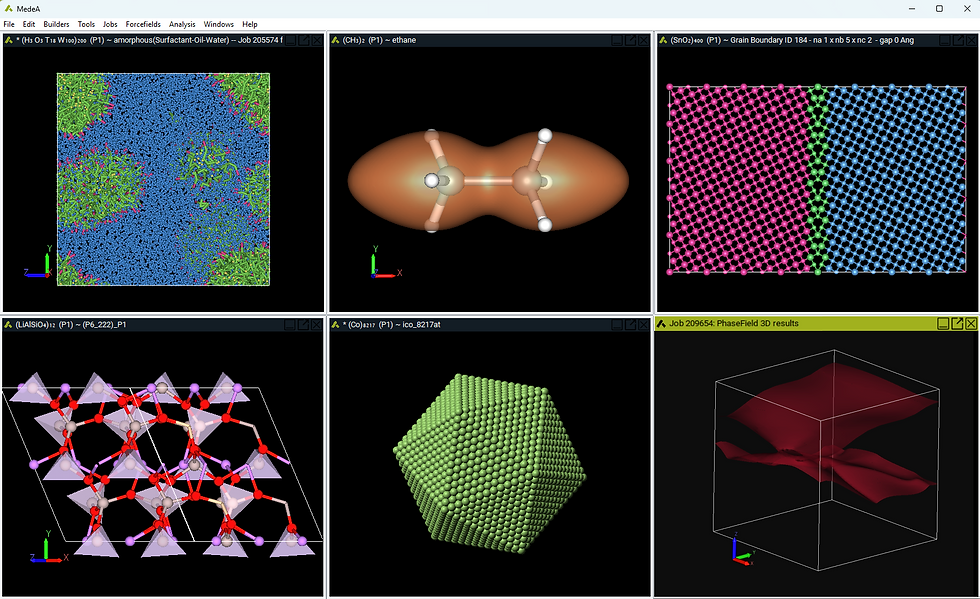MedeA Software Release MedeA 3.4 -- Material Control!
- Katherine Hollingsworth
- Dec 20, 2021
- 3 min read
Materials Design, Inc. Announces the Release of MedeA 3.4, 'Material Control'. MedeA 3.4 includes groundbreaking Machine-Learned Potential (MLP) capabilities, including neural network-based potential models and a fully integrated MLP generator. With these capabilities, users can create highly accurate MLP descriptions of ab initio training sets for use with the LAMMPS simulation environment. These enhancements allow users to simulate systems with first-principles accuracy with substantial system sizes and simulation timescales which greatly exceed those accessible to quantum mechanical methods. "With every release we increase scientific capabilities, ease-of-use, and efficiency for MedeA for materials modelers," said Dr. Benoit Leblanc, Chief Software Architect at Materials Design. "With the MedeA 3.4 release, in addition to providing a unique and efficient Machine-Learned Potential Generator capability, we have significantly updated many of the views and controls that comprise the MedeA interface. These updates make MedeA even more capable, and its interface even more intuitive, responsive, and efficient. From a software design perspective, we are very proud of these enhancements, they provide value to users immediately and, for the programming team, such enhancements facilitate the future development of MedeA." MedeA 3.4 features substantial user interface updates, which enhance productivity and ease-of-use. Additionally, many graphical updates have been made, including enhanced display modes and graphical analysis capabilities. Updates have been made to the VASP interface to facilitate the creation and analysis of large training sets. A bulleted list of major enhancements is provided below. Dr. Leblanc added, "We are committed to serving the expanding community of materials simulators who use the MedeA environment. I am truly delighted to see the output of our software development work having an important effect on materials research in many organizations worldwide and I look forward to hearing your comments and suggestions for future releases."
Description of MedeA 3.4 New Features and Enhancements
1. Builders and Editors:
Updated Builders & Editors
Addition of controls on each system-view window
Easy access to 3D viewing options through the controls on the system-view window
Addition of visual aids / enhancements, such as:
Depth cueing
Control of perspective view
Lighting options
Creation of user-defined profile controlling 3D viewing options
Axes and axes labels and positioning control
Introduction of right panel with "switch" mode for access to multiple panels
Replacement of a number of "floating windows" with right panel (e.g. edit cell/symmetry, supercell builder etc.)
Update of "Docking" tool, including view of energies and ability of selection of any created configuration
Geometric Analysis as a side-panel on the structure-view window (periodic systems)
Several enhancements in the Trajectory animations, including:
Increased rendering speed
Improved efficiency in bond handling
Improved control of viewing (mixed view)
Animation panel on the trajectory animation window
Smart access restriction to trajectories
Structure Lists' animation, including plotting of properties and descriptors that are included / saved therein
2. Engines:
VASP
Accelerated import for large OUTCAR files created by long molecular dynamics simulations
GIBBS
Calculation of sorption grids within the GCMC computation
Accelerated grid construction
Decrease of JS/TS traffic (streamlined grid transfer)
Automated rebuild of grids if deleted or inappropriate
Increased consistency (grid construction and simulation using a single set of binaries)
3. Forcefields:
MLPG
Addition of neural network potentials by adding n2p2 to the MLPG
Efficient inclusion of post-DFT approaches by using "Delta learning"
Bond length, bond angle and torsion angle distribution analysis in the MLP data manager
PCFF+
Refined parameters for trialkyl phosphates
4. Property Modules:
Phonon
Enhanced analysis of Infrared and Raman spectra
Specification of experimental conditions (polarized or unpolarized light / monocrystal or polycrystalline sample)
Specification of incident and scattered light orientation and polarization orientation for Raman spectra
Display of Raman cross section or Raman reduced spectra, handle the temperature (Bose) factor
Enhanced analysis of thermodynamic functions
Analysis of contributions of atoms in Cartesian directions to the thermodynamic functions
Analysis of thermal displacements of atoms as a function of temperature
#mesoscale #machinelearning #modeling #materialscience #VASP #LAMMPS #GIBBS #softwarerelease #compchem
New Modules:



Comments